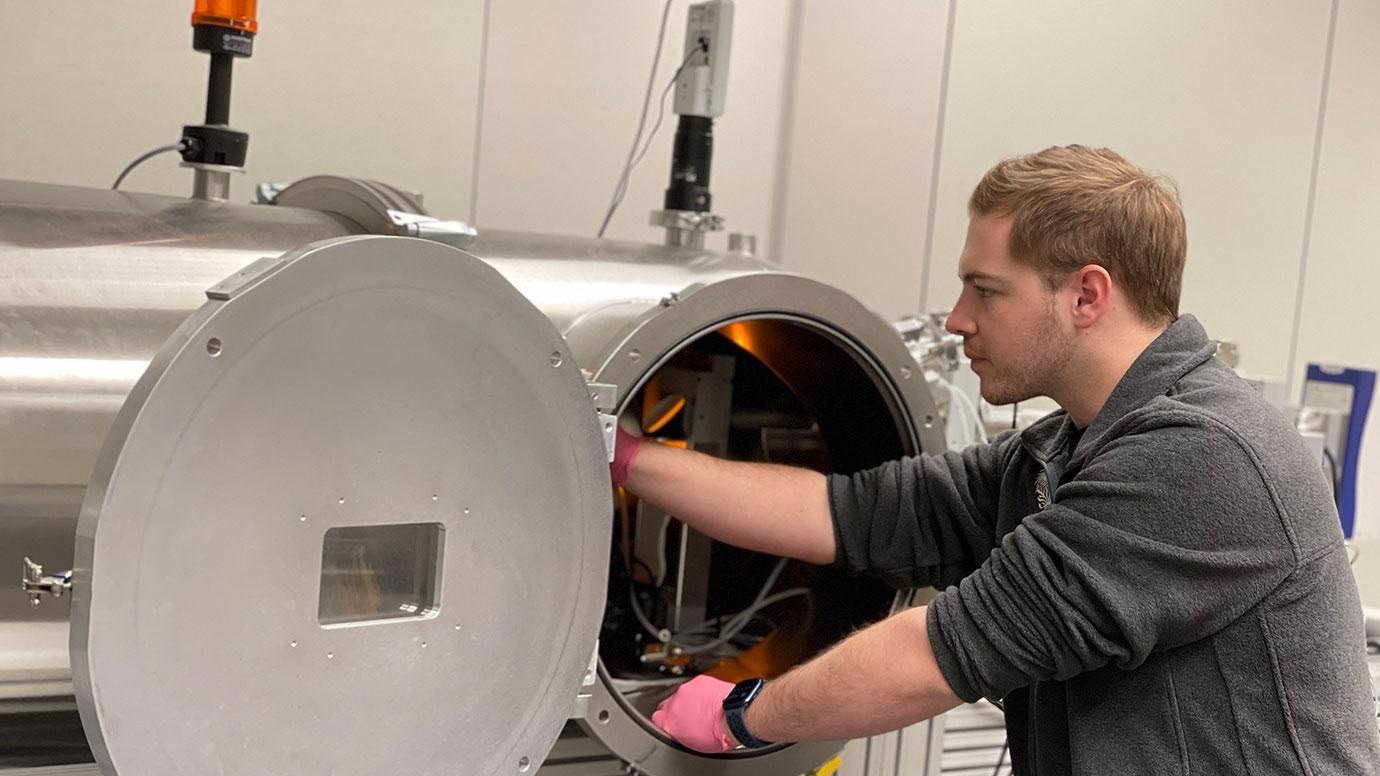Since technical building blocks have shrunk in size since the 1950s, users can now obtain an entire computer in their pocket. However, to create future generations of electronics—for example, more potent phones, more effective solar cells, or even quantum computers—scientists will need to develop entirely new technology at the smallest scales.
 University of Chicago graduate student Josh Portner collects x-ray scattering data from tiny “supercrystals.” Scientists hope such super nanocrystals could form the basis of new technologies thanks to a new method to help them talk to one another electronically. Image Credit: Talapin lab/University of Chicago.
University of Chicago graduate student Josh Portner collects x-ray scattering data from tiny “supercrystals.” Scientists hope such super nanocrystals could form the basis of new technologies thanks to a new method to help them talk to one another electronically. Image Credit: Talapin lab/University of Chicago.
Nanocrystals are one topic of focus. These tiny crystals can gather themselves into a variety of configurations, but researchers have yet to figure out how to get them to communicate with one another.
A new study reports a breakthrough in the electronic interaction of nanocrystals. The study, which was published on March 24 in Science, could pave the way for future devices with enhanced capabilities.
We call these super atomic building blocks because they can grant new abilities—for example, letting cameras see in the infrared range. But until now, it has been very difficult to both assemble them into structures and have them talk to each other. Now for the first time, we don’t have to choose. This is a transformative improvement.
Dmitri Talapin, Study Corresponding Author and Ernest DeWitt Burton Distinguished Service Professor, Chemistry and Molecular Engineering, University of Chicago
According to Josh Portner, a Ph.D. student in chemistry and one of the study’s first authors, the researchers’ paper lays out design rules that should make it possible to create various materials.
A Tiny Problem
Researchers can create nanocrystals from a variety of materials, including metals, semiconductors and magnets, each having unique characteristics. However, whenever they attempted to assemble these nanocrystals into arrays, the new supercrystals grew with long “hairs” around them.
Electrons found it difficult to jump from one nanocrystal to another due to these hairs. Electrons are the electronic communication’s messengers; their capacity to shift quickly is a critical component of any electronic device.
The researcher utilized a method to decrease the number of hairs surrounding each nanocrystal so that they could pile them in more tightly and close the gaps between them.
When these gaps are smaller by just a factor of three, the probability for electrons to jump across is about a billion times higher. It changes very strongly with distance.
Dmitri Talapin, Study Corresponding Author and Ernest DeWitt Burton Distinguished Service Professor, Chemistry and Molecular Engineering, University of Chicago
Talapin is also a senior scientist at Argonne National Laboratory.
To shave the hairs, researchers wanted to find out what was going on at the atomic level. Researchers needed the help of powerful X-Rays at Argonne and the Stanford Synchrotron Radiation Lightsource at SLAC National Accelerator Laboratory, as well as potent simulations and models of the chemistry and physics at work. All of this enabled them to comprehend what was going on beneath the surface—and to discover the key to harnessing their output.
Growing supercrystals in solution—that is, in liquid—is a part of the process. As the crystals develop, they undergo an unexpected transformation in which gas, liquid and solid phases exist side by side. They could generate crystals with harder, slimmer exteriors that could be jammed much closer together by precisely controlling the chemistry of that stage. “Understanding their phase behavior was a massive leap forward for us,” said Portner.
The full scope of applications is unknown, but the researchers envision a range of areas where the method could be useful. “For example, perhaps each crystal could be a qubit in a quantum computer; coupling qubits into arrays is one of the fundamental challenges of quantum technology right now,” said Talapin.
This is a transformative improvement.
Dmitri Talapin, Study Corresponding Author and Ernest DeWitt Burton Distinguished Service Professor, Chemistry and Molecular Engineering, University of Chicago
Portner is also curious about the strange intermediate state of matter observed during supercrystal development. “Triple phase coexistence like this is rare enough that it’s intriguing to think about how to take advantage of this chemistry and build new materials,” adds Portner.
Researchers at the University of Chicago, Technische Universität Dresden, Northwestern University, Arizona State University, SLAC, Lawrence Berkeley National Laboratory, and the University of California, Berkeley participated in the study.
The study was carried out in part at the DOE’s Advanced Materials for Energy-Water Systems Center, the Midwest Integrated Center for Computational Materials, Argonne’s Center for Nanoscale Materials, and the Stanford Synchrotron Radiation Lightsource at the SLAC National Accelerator Laboratory.
Journal Reference:
Coropceanu, I., et al. (2022) Self-assembly of nanocrystals into strongly electronically coupled all-inorganic supercrystals. Science. doi.org/10.1126/science.abm6753.